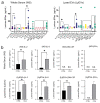Extracellular Vesicles as Markers of Liver Function: Optimized Workflow for Biomarker Identification in Liver Disease
- PMID: 37298585
- PMCID: PMC10253831
- DOI: 10.3390/ijms24119631
Extracellular Vesicles as Markers of Liver Function: Optimized Workflow for Biomarker Identification in Liver Disease
Abstract
Liver diseases represent a significant global health burden, necessitating the development of reliable biomarkers for early detection, prognosis, and therapeutic monitoring. Extracellular vesicles (EVs) have emerged as promising candidates for liver disease biomarkers due to their unique cargo composition, stability, and accessibility in various biological fluids. In this study, we present an optimized workflow for the identification of EVs-based biomarkers in liver disease, encompassing EVs isolation, characterization, cargo analysis, and biomarker validation. Here we show that the levels of microRNAs miR-10a, miR-21, miR-142-3p, miR-150, and miR-223 were different among EVs isolated from patients with nonalcoholic fatty liver disease and autoimmune hepatitis. In addition, IL2, IL8, and interferon-gamma were found to be increased in EVs isolated from patients with cholangiocarcinoma compared with healthy controls. By implementing this optimized workflow, researchers and clinicians can improve the identification and utilization of EVs-based biomarkers, ultimately enhancing liver disease diagnosis, prognosis, and personalized treatment strategies.
Keywords: biomarker; cytokine; extracellular vesicles; liver diseases; microRNA; nanoparticle-tracking analysis.
Conflict of interest statement
The authors declare no conflict of interest.
Figures






References
MeSH terms
Substances
Grants and funding
LinkOut - more resources
Full Text Sources
Medical

